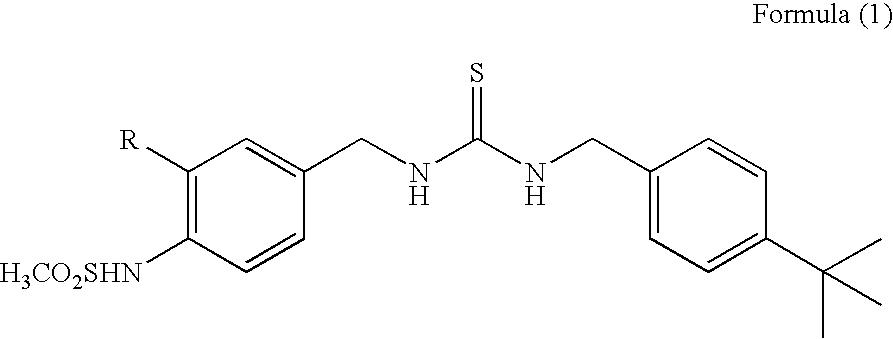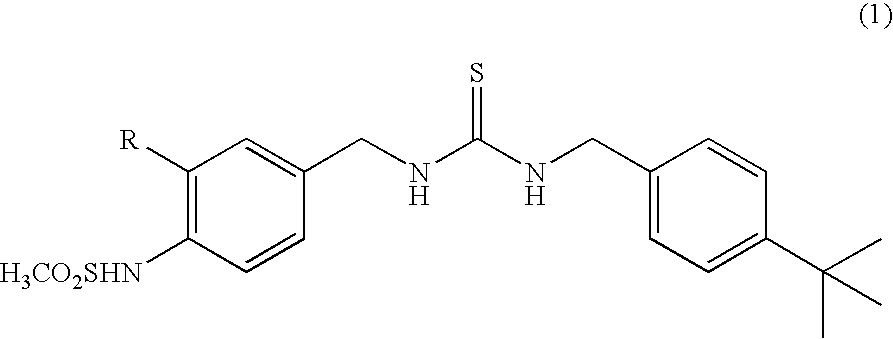A composition containing a thiourea derivative for preventing or treating pruritic or irritant skin diseases
a technology of thiourea and derivatives, applied in the direction of drug compositions, biocide, dermatological disorders, etc., can solve the problems of difficult to determine whether the injected substance is a pruritogen or irritant, and the behavior of scratching the injection site with hind paws is significantly increased
- Summary
- Abstract
- Description
- Claims
- Application Information
AI Technical Summary
Problems solved by technology
Method used
Image
Examples
experimental example
Evaluation of Biological Efficacy
[0036] It was confirmed that the thiourea derivatives of the present invention as vanilloid receptor antagonists exerted antipruritic effects and inhibitory effects on skin irritation in various animal models. The compounds 1 to 3 were used as preferred thiourea derivatives in the following experimental examples.
experimental example 1
[0037] Itching induced by compound 48 / 80 (C48 / 80) in ICR mice (Intradermal Administration)
[0038] ICR mice suffer from itching upon administration of histamines, and C48 / 80 (condensation product of N-methyl-p-methoxyphenethylamine with formaldehyde, Sigma, U.S.A.) is a substance that stimulates connective tissues and skin mast cells to release mediators, such as histamines, causing itching. C48 / 80 causes itching when intradermally administered to humans (Rukwied et al., 2000, Br. J. Pharmacol., 142, pp 114-1120). In this experiment, ICR mice received C48 / 80 to induce itching. One day before the experiment, the rostral part of the skin on the back of male ICR mice (28˜32 g, 4˜11 mice / group) was clipped. After the drug (compound 1, 50 μl / mouse) was dissolved in hydroxypropyl-β-cyclodextrin (HP-β-CD; Mitsubishi Ltd., Japan) and C48 / 80 (50 μg / 50 μl / mouse) was dissolved in a physiological saline solution, the solutions were simultaneously injected intradermally into the back skin of mice...
experimental example 2
[0039] Itching Induced by Compound 48 / 80 (C48 / 80) in BALB / C Mice (Oral administration)
[0040] Itching induced by C48 / 80 in atopic dermatitis patients is not inhibited by histamine (H1) receptor antagonists, which indicates that a substance other than histamine is involved in the itching induction in the atopic patients (Wahlgren et al., 1991, Acta Derm.-Venereol., Suppl. 165, pp 1-53). The frequency of scratching induced by an itching-inducing substance varies depending on mouse strain. For example, it was reported that BALB / C mice are less sensitive to histamines and serotonin than ICR mice (Inagaki et al., 2001, Skin Pharmacol. Appl. Skin Physiol., 14, pp 87-96). This suggests that itching by C48 / 80 in BALB / C mice is similar to that in atopic dermatitis patients. In this experiment, BALB / C mice received C48 / 80 to induce itching. One day before the experiment, the rostral part of the skin on the back of BALB / C mice (19˜21 g, 6˜12 mice / group) was clipped. After compound 1 was dissol...
PUM
| Property | Measurement | Unit |
|---|---|---|
| Fraction | aaaaa | aaaaa |
| Fraction | aaaaa | aaaaa |
| Inhibition | aaaaa | aaaaa |
Abstract
Description
Claims
Application Information
 Login to View More
Login to View More - R&D
- Intellectual Property
- Life Sciences
- Materials
- Tech Scout
- Unparalleled Data Quality
- Higher Quality Content
- 60% Fewer Hallucinations
Browse by: Latest US Patents, China's latest patents, Technical Efficacy Thesaurus, Application Domain, Technology Topic, Popular Technical Reports.
© 2025 PatSnap. All rights reserved.Legal|Privacy policy|Modern Slavery Act Transparency Statement|Sitemap|About US| Contact US: help@patsnap.com


